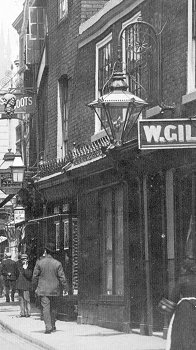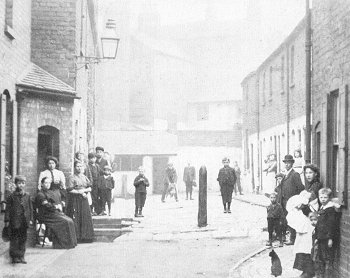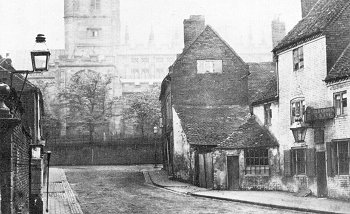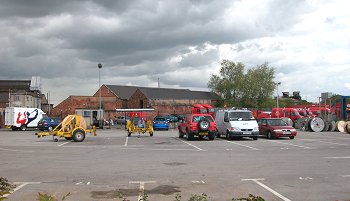|
Horseley Fields Gas Works
In 1794 William Murdock invented the first practical
system of gas lighting by heating coal in a closed
iron vessel, piping it into his house at Redruth in
Cornwall, and using it to light a series of gas
burners. At the time he was employed by Boulton and
Watt of Birmingham, who opposed his involvement with
the invention, preferring him to concentrate on his
job, which consisted of supervising the installation
of Boulton and Watt steam engines in the local tin
mimes. As a result Murdock left the company and
moved back to his native Scotland.
In 1798 Boulton and Watt
offered Murdock the post of Manager at their Soho
Works and agreed to the installation of two gas
lamps outside the factory. This was the first
installation of gas lighting in the country. The
following year it was extended and the whole factory
was illuminated by gas. The company went on to
install many such systems in factories throughout
the country.
People became aware of the
benefits of gas lighting when George IV had it
installed in Carlton House, his London home. Within
a couple of years gas lamps were installed in Pall
Mall, the first street in the world to be lit by
gas. In 1812 the Gas Light and Coke Company opened
the first gas works in the U.K. which supplied gas
to light the City of Westminster. By 1819, 288 miles
of pipes had been laid in London to supply 51,000
burners, and within ten years most of the country’s
larger towns and cities were lit by gas.
Street Lighting in Wolverhampton |
|

An early gas street light. |
Street lighting first appeared in
Wolverhampton in the 1770s in the form of oil lamps. By
1800 a lamp was positioned at every corner and over the
doorway of every Inn. The streets were dimly lit and
remained so for over twenty years until the oil lamps
were replaced by the far superior gas lights.
The Town Improvement Acts compelled
towns to clean, light, pave, and make the streets safe.
After the invention of gas lighting, the Improvement
Acts referred specifically to streets being lit by gas.
Such an Act was passed for Wolverhampton in 1820.
In November 1819, 57 subscribers
purchased shares in a new venture called ‘The
Wolverhampton Gas Light Company’. The company was
incorporated after an Act of Parliament, passed on 27th
June 1820. It stated that the 57 subscribers would fund
the venture, and that the town of Wolverhampton was "a
large and populous place, and it would be of great
advantage to the inhabitants thereof, and to the public
at large, if the streets and other public passages and
places were better lighted". |
|
It also mentioned that "Inflammable
air or gas, being conveyed by means of pipes, may be
safely and beneficially used for lighting the several
streets etc. and for lighting shops, private houses and
buildings, and the coke may be beneficially employed as
fuel in private house and manufactures".
The 57 subscribers included:
|
John Weaver and Benjamin Parton Mander,
paint manufacturers
Chrees and Tompson, solicitors
Henry Hordern, banker
William Ready and William Ryton, constables
William Hanbury Sparrow, ironmaster
Joseph Smart, one of the founders of the
Wolverhampton Chronicle
Richard Fryer, banker and company treasurer
Harry Parkes, Commissioner and company clerk
John Dixon, of Ready and Dixon |
The company’s engineer was John
Grafton who had taken out patents for gas purification
in 1818, 1819 and 1820. The pipes were laid during the
summer and autumn of 1820 by the firm of Ready and
Dixon, and the work was completed by January 1821. |

The location of the gas works. Based on the
1842 Tithe map.
|
Two gasometers were ordered for the
company’s gasworks, which were built in Horseley Fields.
Production began on 17th September 1821.
In 1821 the company celebrated its
achievement by building a 40 forty foot high, cast-iron
column in High Green, with a gas lantern at the top.
Unfortunately it was a disaster, being too high from the
ground to throw sufficient light. The structure was
demolished in 1840. |
| A more noteworthy event happened in 1824 when a new
balloon ascended from the gas works in Horseley Fields.
This was to be the first of several balloon flights that
were made using locally produced gas.
The balloon was piloted by Mr. Green, a well known
balloonists who had made several ascents in the
Midlands, but had never flown from Wolverhampton. Such a
flight was an expensive affair and so he decided to
arrange a flight from Wolverhampton on the understanding
that any spectators would have to pay to watch the event
to reduce the cost. |

Lighting in Gas Yard, Horseley
Fields. It was named after the nearby gasworks. |
| A subscription was guaranteed and the flight was
arranged for 17th September. For a fee of 2 shillings a
spectator could watch the entire event from the Union
Mill yard, that overlooked the gasworks.
Although cloudy, it was a fine day and large numbers
of people gathered in the town, which had never been so
full. People watched from every corner including the top
of St. Peter’s Church tower. The spectators in Union
Mill yard saw the whole event including the inflation of
the magnificent Coronation balloon. Guns were fired to
mark various stages of the process.
Mr. Green was joined in the balloon by Edward Clarke,
a Wolverhampton iron founder. The National Anthem was
played, and the balloon ascended for about a mile before
safely landing on Dunston Heath, near Penkridge. The
flight covered a distance of twelve miles and was a
great success for all concerned. |

Early gas lighting in Horsefair.
The large lamp on the right is above the entrance to the
Old Crown pub. |
Gas installations continued, albeit on a smaller
scale.
On 8th January, 1823 the town’s theatre at the back
of the Swan Inn, off High Green was converted to gas
lighting and the gas company was paid £350 annually for
the gas supplied to the street lamps, which were
provided by the local authority. |
| In 1826 this sum was increased to £420 for the two
hundred lamps, that were each lit for 22 nights a month,
from the middle of September to the middle of April. The
lamps were lit within half an hour of sunset until four
o’clock in the morning, but were not lit on 8 or so days
each month because people were supposed to rely on light
from the full, or nearly full moon. No allowance was
made for the weather or smoke from factory chimneys.
The lighting times remained in use until 1834,
after which the lamps were left on during the winter
months until 7 a.m. for the arrival of the early mail
and other coaches. By 1849 most of the streets in the
town centre were lit by gas, using a total 411 lamps.
Some of the more distant roads such as Penn Road and
Tettenhall Road were also lit. |
| By the late 1840s a larger works was needed to cope
with the rising demand and so in 1849 a new gas works
was built in Stafford Road.
The Corporation decided to purchase the gas company
in the mid 1860s.
Negotiations took place, but the asking price was far
too high for the Corporation and so the scheme was
abandoned. |

The site of the gas works today. |
| In 1869 Wolverhampton Corporation came into conflict
with the gas company. Councillor R. Sidney informed the
council that he understood that the gas company was
using some of its profits to extend Stafford Road works.
According to the Act of Parliament the company could
only distribute a 10 percent dividend amongst the
shareholders, and must have a reserve fund of £5,000.
After this the balance of the profits should go towards
reducing the charges to the customers. As the
Corporation was the largest customer it was thought that
it should be charged less. The Corporation
approached the company on this matter and the directors
challenged the Corporation to prove its claims. The Act
of Parliament under which the gas company operated,
stated that any case of dispute between the company and
its customers should be referred to the Court of Quarter
Sessions at Stafford. Their decision on the matter would
be final.
The case came up for hearing, and the verdict was that
although there were irregularities in the keeping of the
accounts, the Corporation had failed in its contention.
The gas company was ordered to deduct income tax from
any future dividend paid to its shareholders, and
to keep the accounts in better form. At the next meeting
of the Town Council the committee reported that the cost
of the appeal to the Quarter Sessions was £215 and the
result would be a gain for the Corporation. The
directors of the gas company were very disappointed at
the result.
The gas works at Horseley Fields continued to operate
until 1900. The site was soon taken-over by T. & C. Clark to
extend the Shakespeare Foundry. |
 |
Return to the
previous page |
|